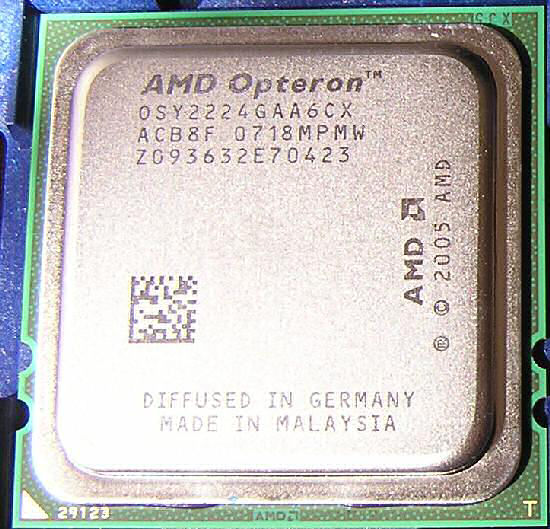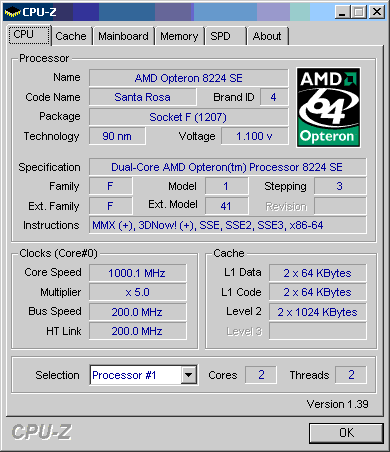A Closer Look at AMD's Newest Offering
AMD thus brings four new CPUs into the server space:

The Opteron 2224 package
To position AMD's new Opteron 2224 offering we take a look at the most interesting Intel and AMD CPUs at the current date.
So basically, AMD's 120W Dual core 3.2GHz Opteron has to prove that it is a worthy competitor to two Intel offerings:
This means that the software only has to make use of two CPU cores (eight cores needs four instances), which is a lot easier than making use of all eight cores in a single instance. This kind of "multi instance" benchmarking may reflect the way quite a few people and businesses use their servers, but at the same time such benchmarks can paint a picture that is far too optimistic for those people who are only running one application on their server.
Secondly, it might seem like a dual Opteron 2224 needs 80W more, but the reality is different. Intel's Northbridge consumes up to 20W more, and each FB-DIMM needs about 5W more than the DDR modules the AMD platform uses. So the difference is not as big as it might seem at first, something we have shown in a previous article. The AMD CPUs also scale back to 1GHz when running at idle, while the Intel CPUs run at 1.6 or 2GHz when idle. As a result the AMD platforms can consume less power when idle or at lower loads.

The Opteron runs now at 3.2GHz
As you can see in the animated gif above, the CPU is capable of scaling back to 1GHz and 1.1V. It can also run at 2.8GHz at 1.275V, and it needs 1.375V to run at 3.2GHz. PowerNow! enables it to run at any frequency between 1.6GHz to 2.8GHz in steps of 200MHz. Keep this in mind when we look at some power figures later on.
AMD thus brings four new CPUs into the server space:
- A 3.2GHz Opteron which consumes at most 120W, in dual and quad/octal socket versions
- A 3GHz Opteron 8222 and 2222 which used to consume up to 120W, but which are - thanks to process improvements - now limited to 95W

The Opteron 2224 package
To position AMD's new Opteron 2224 offering we take a look at the most interesting Intel and AMD CPUs at the current date.
| Intel Processor Overview | ||||||||
| Intel CPU | Clock | Codename | L2 | L3 | FSB | Mem bandwidth | TDP | Price |
| Dual NetBurst CPUs | ||||||||
| Xeon MP 7140M | 3.4GHz | Tulsa | 2x1MB | 16MB | 200MHz Quad | 6.4 GB/s | 150W | $1,980 |
| Xeon MP 7130M | 3.2GHz | Tulsa | 2x1MB | 8MB | 200MHz Quad | 6.4 GB/s | 150W | $1,391 |
| Xeon MP 7120M | 3GHz | Tulsa | 2x1MB | 4MB | 200MHz Quad | 6.4 GB/s | 95W | $1,117 |
| Quad Core CPUs | ||||||||
| Xeon E5355 | 2.66GHz | Clovertown | 2x4MB | - | 333MHz Quad | 21 GB/s | 120W | $1,172 |
| Xeon E5345 | 2.33GHz | Clovertown | 2x4MB | - | 333MHz Quad | 21 GB/s | 80W | $851 |
| Xeon E5320 | 1.86GHz | Clovertown | 2x4MB | - | 266MHz Quad | 17 GB/s | 80W | $690 |
| Dual Core CPUs | ||||||||
| Xeon DP 5160 | 3GHz | Woodcrest | 4MB | - | 333MHz Quad | 21 GB/s | 80W | $851 |
| Xeon DP 5150 | 2.66GHz | Woodcrest | 4MB | - | 333MHz Quad | 21 GB/s | 65W | $690 |
| Xeon DP 5148 | 2.33GHz | Woodcrest | 4MB | - | 333MHz Quad | 21 GB/s | 40W | $519 |
| AMD Processor Overview | ||||||||
| AMD CPU | Clock | Codename | L2 | L3 | HT | Mem bandwidth | TDP | Price |
| Eight-Way CPUs | ||||||||
| Opteron 8224 SE | 3.2GHz | Santa Rosa | 2x1MB | - | 1000MHz DDR | 10.6 GB/s | 119W | $2,149 |
| Opteron 8222 | 3GHz | Santa Rosa | 2x1MB | - | 1000MHz DDR | 10.6 GB/s | 95W | $1,514 |
| Opteron 8220 | 2.8GHz | Santa Rosa | 2x1MB | - | 1000MHz DDR | 10.6 GB/s | 95W | $1,165 |
| Opteron 8218 | 2.6GHz | Santa Rosa | 2x1MB | - | 1000MHz DDR | 10.6 GB/s | 95W | $873 |
| Opteron 8218 HE | 2.6GHz | Santa Rosa | 2x1MB | - | 1000MHz DDR | 10.6 GB/s | 68W | $1,019 |
| Two-Way CPUs | ||||||||
| Opteron 2224 SE | 3.2GHz | Santa Rosa | 2x1MB | - | 1000MHz DDR | 10.6 GB/s | 119W | $873 |
| Opteron 2222 | 3GHz | Santa Rosa | 2x1MB | - | 1000MHz DDR | 10.6 GB/s | 95W | $698 |
| Opteron 2220 | 2.8GHz | Santa Rosa | 2x1MB | - | 1000MHz DDR | 10.6 GB/s | 95W | $523 |
| Opteron 2218 | 2.6GHz | Santa Rosa | 2x1MB | - | 1000MHz DDR | 10.6 GB/s | 95W | $377 |
| Opteron 2218 HE | 2.6GHz | Santa Rosa | 2x1MB | - | 1000MHz DDR | 10.6 GB/s | 68W | $450 |
So basically, AMD's 120W Dual core 3.2GHz Opteron has to prove that it is a worthy competitor to two Intel offerings:
- The dual core Xeon 5160 3GHz with a TDP of 80W
- The quad core Xeon 5345 2.33 with a TDP of 80W
This means that the software only has to make use of two CPU cores (eight cores needs four instances), which is a lot easier than making use of all eight cores in a single instance. This kind of "multi instance" benchmarking may reflect the way quite a few people and businesses use their servers, but at the same time such benchmarks can paint a picture that is far too optimistic for those people who are only running one application on their server.
Secondly, it might seem like a dual Opteron 2224 needs 80W more, but the reality is different. Intel's Northbridge consumes up to 20W more, and each FB-DIMM needs about 5W more than the DDR modules the AMD platform uses. So the difference is not as big as it might seem at first, something we have shown in a previous article. The AMD CPUs also scale back to 1GHz when running at idle, while the Intel CPUs run at 1.6 or 2GHz when idle. As a result the AMD platforms can consume less power when idle or at lower loads.

The Opteron runs now at 3.2GHz
As you can see in the animated gif above, the CPU is capable of scaling back to 1GHz and 1.1V. It can also run at 2.8GHz at 1.275V, and it needs 1.375V to run at 3.2GHz. PowerNow! enables it to run at any frequency between 1.6GHz to 2.8GHz in steps of 200MHz. Keep this in mind when we look at some power figures later on.










30 Comments
View All Comments
piroroadkill - Tuesday, August 7, 2007 - link
it is a car analogyGul Westfale - Monday, August 6, 2007 - link
good analogy there, except that mustangs (and various other cars) use pickup truck engines for cost reasons. large trucks use larger engines (often diesels) because they offer considerably more torque at much lower RPM than a smaller gasoline engine; and thus provide more pulling power.Gul Westfale - Monday, August 6, 2007 - link
these are not regular consumer cpus, but intended for use in commercial servers and workstations. they and their motherboards cost more because they support features such as multiple sockets (so in addition to having multiple cores on one chip you can also have multiple chips on one motherboard).yyrkoon - Monday, August 6, 2007 - link
they win 1 of 2 tests, and it is clear they are the winner ? Why ? Because they won the software rendering also ? Anyone interrested enough in rendering, and HAVING to have this sort of hardware for it is NOT going to bother with software . . .
This means your conclusion on this point is incorrect, and in which case, it boils down to which application the rendering machine is going to do.
Man you guys come to the wierdest conclusions based on your own data, and I am not even the first to notice/mention this sort of thing . . .
JohanAnandtech - Monday, August 6, 2007 - link
The Quadcore wins all high resolution rendering tests. Where do you see the DC opterons win against the Quadcore Intel in high resolution rendering? Show me a rendering engine where a 3 GHz K8 DC core is faster in high resolution renderering than a 2.33 GHz Quadcore. All decent and used in the realworld rendering engines will more or less show the same picture.In fact, the "rendering performance" situation will get worse for the K8 as SSE-2 tuning will get more common. All Intel CPUs since core and all AMD CPUs since Barcelona will show (or are already showing) high performance boost from using better SSE-2 code.
yyrkoon - Monday, August 6, 2007 - link
Ok, I see now with the graphs 'lower is better' on 3ds max, I missed that with the tables, which is actually what I meant this morning 'table obfustication'. I personally do not mind tables, but when the data is not in a uniform spot, it confuses/makes it harder to read at a glance.Anyhow, I was tired when I posted this morning, cranky, and was overly harsh I think. However it *is* much easier for me personaly to read the graphs at a glance (I cannot speak for everyone though).
yyrkoon - Monday, August 6, 2007 - link
Oh, and while on the subject, you guys here at anandtech have lately mastered the art of graph obfustication. Is it really THAT hard leaving items in the same rows / columns for different tests ? Are we trying to confuse the results, or is there some other reason this happens, and has gone completely over my head ?JohanAnandtech - Monday, August 6, 2007 - link
The only reason is that until very recently I didn't master the graphing engine. I got some weird error messages and gave up. But I have found the error, and you should see some nice graphs which don't obfusticate...Spoelie - Monday, August 6, 2007 - link
the gif on page 2 is non-looping, so after a very quick jump from 1ghz -> 2.8ghz (why??) -> 3.2ghz , it stays put on the 3.2ghz image. If reading the article, by the time the reader sees the image, it's already 5 minutes on the last image and staying there, making it for all intents and purposes a static image instead of an animated one:)
JohanAnandtech - Monday, August 6, 2007 - link
Thanks, fixed that. The reason to show 2.8 GHz is that for example Specjbb and other applications sometimes don't completely stress the CPU and then the cpu dynamically goes back to 2.8 GHz. It are simply the 3 stages I saw the most, and found the most interesting to show.